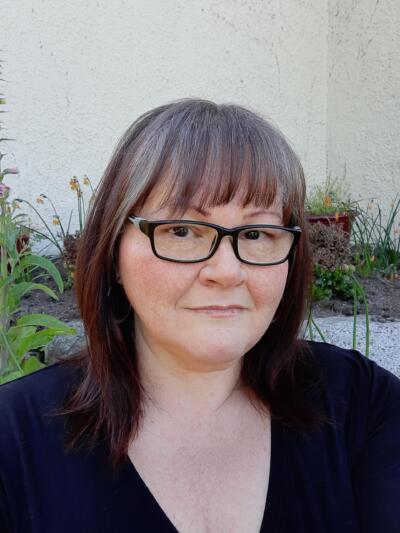Educating educators
Wayi Wah!: Indigenous Pedagogies: An Act for Reconciliation and Anti-Racist Education
by Jo Chrona
Winnipeg: Portage & Main Press, 2022
$32.00 / 9781774920466
by Kenneth Favrholdt
*
 Jo Chrona uses a rallying cry for her book: Wayi Wah! (Let’s go; it’s time!) It is time to make education a force in reconciliation. This is the message.
Jo Chrona uses a rallying cry for her book: Wayi Wah! (Let’s go; it’s time!) It is time to make education a force in reconciliation. This is the message.
Chrona has assembled in eight sequential chapters what could be called a workbook on how to help non-Indigenous educators who are learning about Indigenous pedagogies, Reconciliation through education, and creating Indigenous -specific anti-racist education environments.
In Chapter One, Chrona situates herself. Chrona is of the Kitsumkalum First Nation, along the Skeena River, where her mother and grandmother were born. She has a European biological father and stepfather. She was born in Kxeen (Prince Rupert). She ended up teaching K-12 and went on to obtain a masters degree. As I write this review on this year’s Truth and Reconciliation Day, I am reminded of my own pathway into the world of education. Like Chrona, I went to Simon Fraser University to obtain my teaching certificate. She makes an important observation that applies to all teachers: “In all my experiences as an educator, I have also been a learner.” This is what her book is about.
In Chapter Two, Chrona makes an important point that Indigenous education is not multicultural education. She says that attempts to embed Indigenous education within a conversation about multiculturalism “deny the distinctiveness of First Nations, Inuit, and Métis peoples and undermine actions to acknowledge Indigenous rights.”
In Chapter Three, Chrona touches on the subject of residential schools but also ongoing colonization and decolonization – “the continuing process of critically examining and challenging beliefs, values, structures and processes that are steeped in mindsets that devalue or exclude Indigenous peoples…”

Chapter Four is about the R-word – racism. Chrona speaks about investigating our assumptions that we live by. She provides a list of approaches “to interrogate our own practices and our own biases.” She talks of how “[e]xamining privilege helps us understand how people’s experiences differ.”
Overt racism, such as bullying, teasing, or name-calling felt by Indigenous learners in the classroom needs to be addressed. Systemic racism is where services reflected in inequities, policies, and processes perpetuate disparity in educational outcomes.
Chapter Five focuses on “the First Peoples Principles of Learning” (FPPL) – a set of learning principles that represents “an attempt by a diverse group to identify commonalities in Indigenous knowledge systems about effective approaches to teaching.” The FPPL encompasses a pedagogical approach and an explicit valuing of Indigenous knowledges. Chrona provides a closer look at the principles: learning supporting the well-being of self; learning supporting the well-being of family and community; learning supporting the well-being of the land; and learning supporting the well-being of the spirits and the ancestors.
Indigenous knowledge, states Chrona, refers to “the complex knowledge systems that have been developed over time by a particular people in a particular area and that have been transmitted from generation to generation.” She uses the plural because there is not one but many sets of IK. She quotes Marie Battiste, a Mi’kmaw from Potlotek First Nation and professor emerita at the University of Saskatchewan, quotes Chrona,
[IK] … embodies a web of relationships with a specific ecological context; contains linguistic categories, rules and relationships unique to each knowledge system; has localized context and meaning; has established customs with respect to acquiring and sharing of knowledge…; and implies responsibilities for possessing various kinds of knowledge (Indigenous Knowledge: Foundations for First Nations, 2005).
Chrona underscores “how important it is to teach only knowledge that I have permission from the Nation to share.” Including IK in the curriculum “honours the fact that Indigenous Peoples have rich, robust and deep knowledge systems that have previously either been ignored or devalued as a result of colonial policies and racist attitudes.”
“Non-Indigenous educators should not see themselves as teachers of Indigenous cultures, rather, to teach about Indigenous Peoples, cultures, knowledges, histories and communities.”
Chapter Six is devoted to a discussion of resources used in the classroom and schools in general. Chrona emphasizes the importance of using locally-developed resources and makes an important point throughout the book about avoiding the “pan-Indigenous approach to Indigenous knowledge systems, perspectives and worldviews.” Referring to her own experience, Chrona says that she is a Ts’msyen person currently living on the traditional territories of the Esquimalt and Songhees Nations. But she would not use the traditional knowledge of her homeland and teach that elsewhere.
An example of a locally-based resource is one I was involved in as a teacher at Thompson Rivers University in Kamloops, as part of a research team which produced a booklet, “A Handbook for Educators of Aboriginal Students” (2010) based on the knowledge of the Secwépemc people of the Interior Salish in south-central BC. It draws on the work of scholars like the late Dr. Mary Thomas and that of various First Nations and schools such as Chief Atahm School founded in 1991 at Adams Lake Band.
There is an important section in this chapter on cultural appropriation which occurs when non-Indigenous people take and present elements of Indigenous knowledge as their own, without consent, and without recognition of the source. Such appropriation is often due to ignorance or intentional acts. Cultural appropriation has been defined as “the inappropriate or unacknowledged adoption of an element or elements of one culture or identity by members of another culture or identity” (Wikipedia, accessed Oct. 1, 2023). It is a controversial matter. Art is an area where cultural appropriation is particularly common, given the exploitation of Indigenous culture in areas like art, fashion, and commercial products.
Chapter Seven discusses government commitments and obligations such as British Columbia’s adoption of UNDRIP, the United Nations Declaration on the Rights of Indigenous Peoples. Changes in curriculum and Indigenous-focused courses for graduation requirements are described.
Throughout the book Chrona poses “Reflection Questions,” meant to awaken our own beliefs and biases. For example, “What is your story of how you came to be where you are?”; “What are the stories you are telling about how this country came to be?” Questions are followed by “Taking Action” points.
The book includes an excellent list of resources with each chapter. There is also a selective list of references at the end of the book.
Chrona ends with a truism of education: “We learn, we unlearn, we relearn.” An example of this transformation is displayed in Figure 4.1 in the book, “Becoming Anti-Racist in Canada.” It asks you, the educator, to identify what you used to think about something, then compare it to what you think after engaging in a learning experience, and how your thinking has changed as you continue to learn.
The journey of an educator, that Chrona has so ably shown, is never-ending. She has written, in a clear, direct voice, an important book which is essential reading for everyone working with Indigenous peoples in the education system.

*

Kenneth Favrholdt is a freelance writer, historical geographer and museologist with a BA and MA (Geography, UBC), a teaching certificate (SFU), and certificates as a museum curator. He spent ten years at the Kamloops Museum & Archives, five at the Secwépemc Museum and Heritage Park, four at the Osoyoos Museum, and he is now Archivist of Tk’emlúps te Secwépemc. He has written extensively on local history in Kamloops This Week, the former Kamloops Daily News, the Claresholm Local Press, and other community papers. Ken has also written book reviews for BC Studies and articles for BC History, Canadian Cowboy Country Magazine, Cartographica, Cartouche, and MUSE (magazine of the Canadian Museums Association). He taught geography courses at Thompson Rivers University and edited the Canadian Encyclopedia, geography textbooks, and a commemorative history for the Town of Oliver and Osoyoos Indian Band. Ken has undertaken research for several Interior First Nations and is now working on books on the fur trade of Kamloops and the gold rush journal of John Clapperton, a Nicola Valley pioneer and Caribooite. He lives in Kamloops. [Editor’s note: Ken Favrholdt has recently reviewed books by Marc G. Stevenson, George H. S. Duddy, Terrance N. James, Mali Bain, Liz Bryan, Erín Moure & Anne Callison for The British Columbia Review.]
*
The British Columbia Review
Interim Editors, 2023-24: Trevor Marc Hughes (non-fiction), Brett Josef Grubisic (fiction)
Publisher: Richard Mackie
Formerly The Ormsby Review, The British Columbia Review is an on-line book review and journal service for BC writers and readers. The Advisory Board now consists of Jean Barman, Wade Davis, Robin Fisher, Barry Gough, Hugh Johnston, Kathy Mezei, Patricia Roy, Maria Tippett, and Graeme Wynn. Provincial Government Patron (since September 2018): Creative BC. Honorary Patron: Yosef Wosk. Scholarly Patron: SFU Graduate Liberal Studies. The British Columbia Review was founded in 2016 by Richard Mackie and Alan Twigg.
“Only connect.” – E.M. Forster
2 comments on “Educating educators”